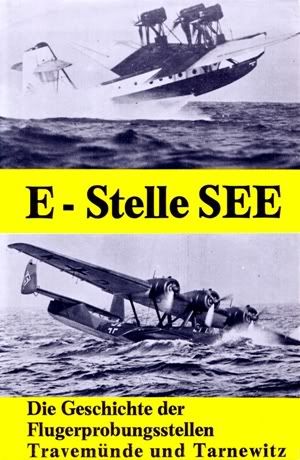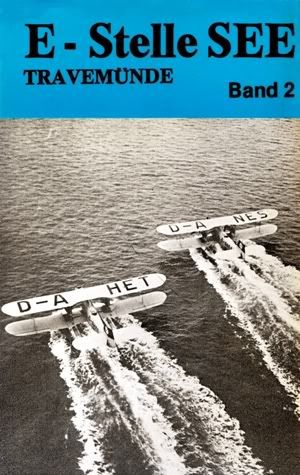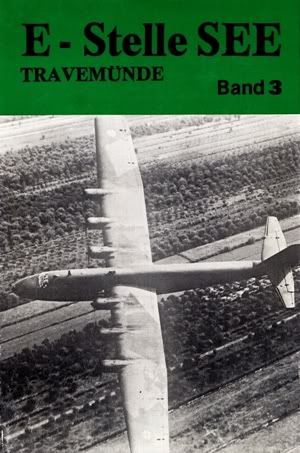
E-Stelle See - Die Geschichte der Seeflug-Erprobungsstelle Travemünde und der daraus hervorgegangenen E-Stelle für Flugzeugbewaffnung in Tarnewitz
Edited by Heinrich Wollé, Dr. H.A. Caspari & Oskar Passoth, Luftfahrt-Verlag Axel Zuerl, Steinebach-Wörthsee, Germany, 1972. Illustrated, hardcover, 130 x 200 mm, 312 printed pages, published in German.

E-Stelle See Travemünde - Die Geschichte der Seeflug-Erprobungsstelle Travemünde und der daraus hervorgegangenen E-Stelle für Flugzeugbewaffnung in Tarnewitz - Band 2
Edited by Heinrich Wollé, Dr. H.A. Caspari & Oskar Passoth, Luftfahrt-Verlag Axel Zuerl, Steinebach-Wörthsee, Germany, [year?], ISBN 3-87500-024-2. Illustrated, hardcover, 130 x 200 mm, 336 printed pages, published in German.

E-Stelle See - Die Geschichte der Seeflug-Erprobungsstelle Travemünde und der daraus hervorgegangenen E-Stelle für Flugzeugbewaffnung in Tarnewitz - Band 3
Edited by Heinrich Wollé, Dr. H.A. Caspari & Oskar Passoth, Luftfahrt-Verlag Axel Zuerl, Steinebach-Wörthsee, Germany, [year?]. Illustrated, hardcover, 130 x 200 mm, 320 printed pages, published in German.
Cover images © by Luftfahrt-Verlag Axel Zuerl.
These three books constitute one of the most comprehensive series of publications on a specific topic related to the Luftwaffe. And in spite of having been published decades ago, their contents are still relevant. Some of the information contained in the three volumes of E-Stelle See has in the meantime found its way into more recent magazine articles or books, but the combined 968 pages of this study still make it an undisputed and excellent single source reference on the seaplane testing center Travemünde and the affiliated aircraft armament testing center in Tarnewitz.
I first found out about E-Stelle See when, as a teenager, I read glowing reviews about these books in German specialist magazines Modell Magazin and Modell Fan in 1976 and 1980. It took until the early 2000s until I finally managed to track down pristine second hand copies of what had by then become collector's items. They were well worth the patience and persistence, however. Incidentally, a small address sticker in my copy of volume 2 shows that this book was once owned by one of the editors of Modell Fan magazine!
The three volumes of E-Stelle See are a collection of accounts, records, and archive material by former members of the Travemünde and Tarnewitz testing centers. Over a dozen authors thus contributed to make this a very wide-ranging compilation of facts and images, although the introduction states explicitly that there are inevitable gaps in the information thus compiled.
E-Stelle See opens with a brief history of German seaplane aviation and the inception of the Travemünde testing center. Even from the very beginning, there are remarkable photographs showing, for example, the testing center, the Dornier Do X in the dry dock, and Junkers, Heinkel, Dornier, and Rohrbach aircraft of the period. A frequent drawback is that the photos are often printed to a rather small size due to the fairly small dimensions of these books. In addition to the plentiful photo content of E-Stelle See, the text is also supported by tables, original documents, and drawings.
The narrative then describes the massive development of the testing center undertaken after 1933 and following the official establishment of the Luftwaffe. More modern aircraft types soon enter the picture, such as the Heinkel He 59, Blohm & Voss BV 138, Arado Ar 195, or Fieseler Fi 168. Also intriguing are the trials conducted with the Focke Achgelis Fa 330. The text continues to be generously illustrated with photos which are at times so specialized that one is unlikely to find them in any other, more generalized publication.
The wealth of material is simply far too extensive to be listed in full here. A few examples:
- engine and armament evaluation
- weapons testing in Tarnewitz, including, for example, turret development, or the various cannon fitted to the Henschel Hs 123
- Rohrbach flying boats
- sea trials in various conditions and involving the He 115, Ha 140, and Ar 196
- catapults and catapult testing with the Fi 168, Ar 197, Bf 109, Ju 87, and even the Ar 96
- landing trials with a Fieseler Fi 156 on board of the ship "Greif"
- evaluation of the Bf 109, Fw 159, Ar 80 and He 112
- helicopter testing
- evaluation of navigation and radio equipment
- tests involving flotation gear in aircraft
- supply flights to Narvik with BV 138 and Do 24
- organization of the RLM testing centers
- aircraft carrier-based version of the Ju 87
- a large section dedicated to affiliated ships and boats
- an illustrated list of German seaplanes and flying boats from 1920 to 1945
and much more.
One of the most intriguing sections reveals just how many aircraft carriers Germany was planning to build. Next to the well-known "Graf Zeppelin", which is covered in somewhat greater detail, drawings illustrate the projected (and, in some instances, commenced) "Flugzeugträger B" (a.k.a "Peter Strasser"), "Weser I", "De Grasse", "Europa", "Elbe I", "Elbe II", and the converted "Gneisenau".
Newer publications - such as, for example, Flugerprobungsstellen bis 1945 (Heinrich Bauvais, Karl Kössler, Max Mayer & Christoph Regel, Bernard & Graefe Verlag, Germany, 1998) - have since also covered this topic and included newer research. But E-Stelle See remains an essential and utterly abounding three-volume study on a most fascinating aspect of past German military aviation.